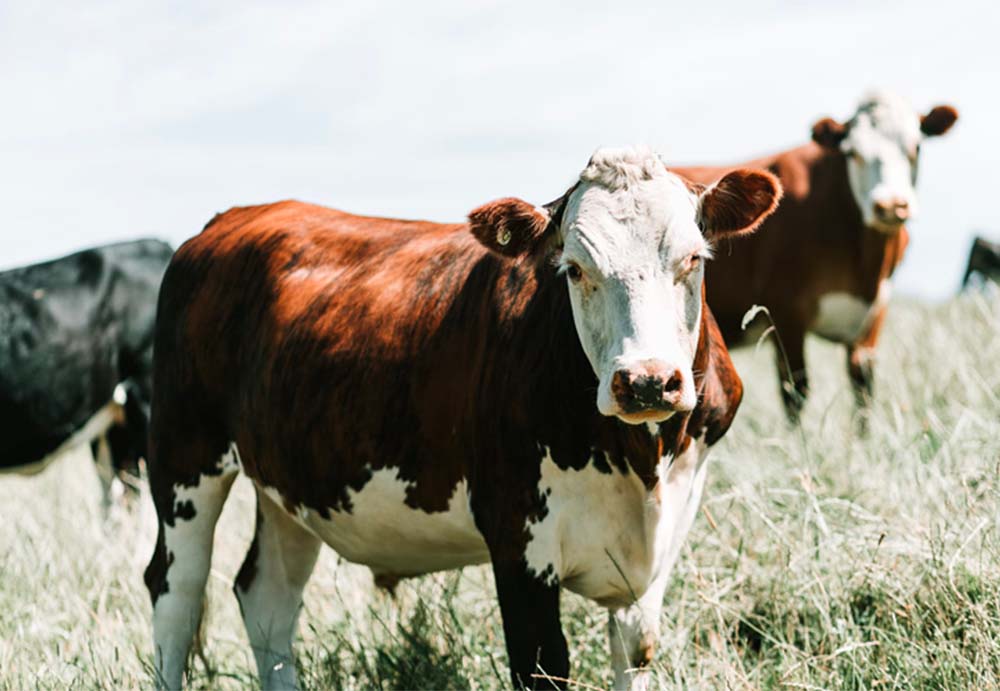What is an Internal Parasite?
Internal parasites live inside the body of the host and then are passed through the body in the manure to finish their life cycle. Liver fluke and roundworms cause the biggest problems for Victorian producers.
These roundworm species include:
- Ostertagia osteragi – small brown stomach worm. This worm has the biggest influence on productivity in Victoria
- Trichostrongylus axei – stomach hair worm
- Cooperia oncophora – intestinal worm
- Haemonchus placei – Barber’s pole worm. Found more frequently in northern Victoria
Trichostrongylus and Cooperia worm species rarely have a severe impact in beef cattle on their own. However, combined with an Ostertagia infection, the effects of these worms are increased.
For more information about liver fluke.
If internal parasites are not managed properly, they can cause substantial economic losses due to the impact it has on production efficiency.
Roundworm Lifecycle
Although there are many different species of roundworms which can infect cattle, their lifecycles are similar.
- First stage of larvae (L1): Female worms lay eggs that are excreted in the manure, which then hatch and develop into infective larvae living in the manure.
- Second stage of larvae (L2): The larvae then continue to feed on the bacteria in the manure, growing and moulting into second-stage larvae.
- Third stage of larvae (L3): The larvae then emerge from the manure onto pasture and are therefore able to infect cattle when ingested with the pasture. Also known as infective larvae or parasitic stage once the larvae have been ingested.
- Fourth stage of larvae (L4): Adult worms then develop in the abomasum (4th stomach) and usually occurs within 3 weeks following ingestion. This damages the lining of the stomach and affects its ability to absorb nutrients, which leads to weight loss and decreasing growth rates.
Small Brown Stomach Worm
Small brown stomach worm are small red-brown worms, 8-12 mm in length and just visible on the lining of the fourth stomach (abomasum).
Also known as Ostertagia Osteragi, this gastrointestinal worm is the most prominent production-limiting species of roundworm in cattle. Its life cycle is similar to most other roundworm species, however it can be delayed by weather or factors within the animal.
There are two types of diseases that come from the small brown stomach worm.
Type 1
This affects young cattle between 15-20 months old when they ingest large numbers of infective larvae (L3) over a short period of time. This usually happens during winter and spring
Type 2
First/second time calvers are most susceptible during the autumn and winter months, however older cows and bulls may be infected. The stress of calving can intensify the symptoms of disease. Usually only a few animals in the mob are affected at any one time because of the erratic development of dormant larvae.
Diagnosis
Cattle herds may end up with disease, and sometimes death.
- Severe scouring
- Ill-thrift (when stock grow at a slower growth rate than expected, given their feed allocation)
- Reduced growth rates
- Weight loss
- Rough coat
- Poor milk production
A worm egg count (WEC) is recommended for cattle under 12 months as they are the most susceptible. These tests will detect worm burdens and a second WEC should be done two weeks after drenching to determine drench efficacy.
You can contact your local vet or send samples to a lab.
Integrated Parasite Management
Producers should use a combination of nutrition management and drenching to control worms. This will decrease the likelihood of becoming reliant on drenches to cure the problem and dramatically reduces the chance of drench resistance within the herd.
Adult cattle generally develop a solid immunity to parasites (worms and fluke) by two years of age and under normal circumstances, cows do not require treatment.
Grazing and Nutrition Management
Animals that are provided with adequate nutrition are able to cope with worm burdens better, increasing the rate of recovery. Grazing cattle, particularly young stock, on lower risk pastures will enhance the efficacy of drenching. That is, they should graze on pastures with low numbers of infective larvae (L3).
To get a low risk pasture, you can:
- Rotate the grazing animals
- Only return cattle to graze on pastures that haven’t been grazed by cattle in the last 4 months
- Sow a new pasture
Drenching
As immunity to Ostertagia is slow to develop, the most important feature of a drench is persistency against Ostertagia.
There are three groups of drenches commercially available for the treatment of worms.
- Benzimidazole or white drenches
- Levamisole or clear drenches
- Macrocyclic lactone or Mectin drenches
Further Resources
For more information to help you create a parasite management plan specific to your herd, visit WormBoss.
AgVic – Worm control for weaned stock
WormBoss/ParaBoss
Click here to download a PDF version.
For further information, please contact the VFF Stock Sense on 1300 882 833 or by email [email protected]

